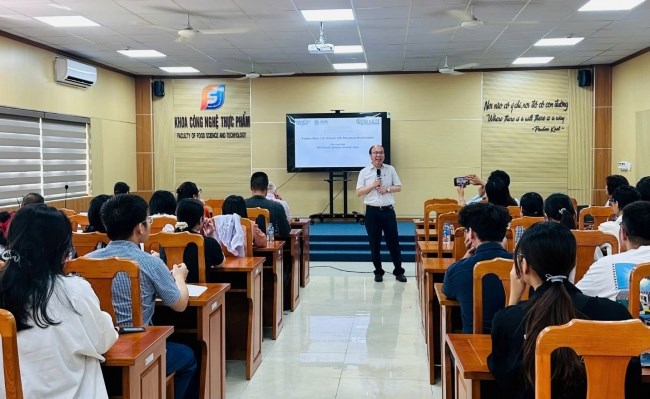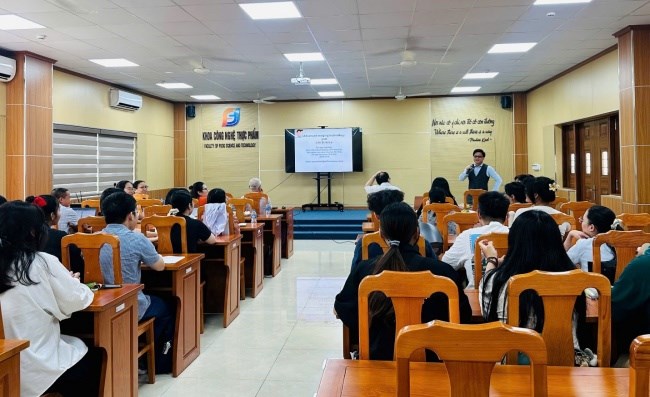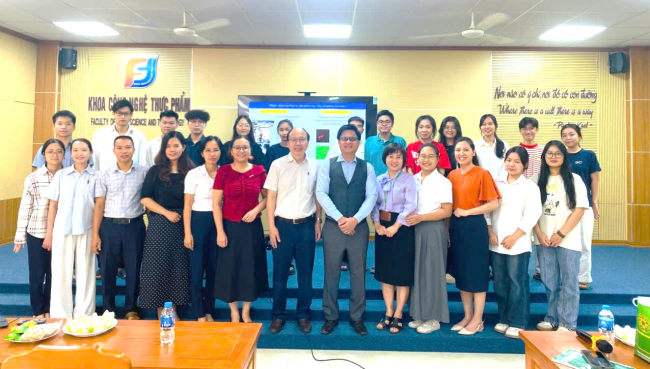On the morning of September 27, 2025, at the Faculty of Food Science and Technology, Vietnam National University of Agriculture, a scientific seminar with the theme “Advanced Imaging Technology in Life Science Research” was held by the research group of Microbiology and Food Safety, featuring a keynote presentation by Dr. Ngo Xuan Kien, Assistant Professor, Nano-Life Science Institute (NanoLSI), Kanazawa University, Japan.
At the opening session, Assoc. Prof. Dr. Nguyen Hoang Anh, Dean of the Faculty of Food Science and Technology, extended a warm welcome to the speaker and all participants. The presence of numerous lecturers, researchers, graduate students, and undergraduates created an engaging and interactive academic atmosphere.

Dr. Ngo Xuan Kien, an alumnus of the 41st cohort of the Faculty of Food Science and Technology, pursued his postgraduate studies in Japan at Osaka University with a government scholarship. He is currently an assistant professor at Kanazawa University and a member of the Vietnam Biophysics Association.
With nearly two decades of research experience in Japan, Dr. Kien has developed a distinctive interdisciplinary approach that integrates biochemistry, biophysics, and mathematical modeling to investigate protein structure and function. His studies on actin, microtubules, and transport proteins have made significant contributions to the advancement of modern life sciences.

In his presentation, Dr. Kien focused on introducing HS-AFM (High-Speed Atomic Force Microscopy), an advanced technology that allows direct observation of biological molecules with nanometer resolution and real time.
He explained in detail the working mechanism, advantages and disadvantages compared to existing techniques, and illustrated them with many practical studies. HS-AFM has been successfully applied in observing the binding of cofilin to actin filaments as well as protein-lipid interactions, thereby opening up great prospects in the design of new generation drugs.
The discussion session recorded many questions from the participants, focusing on in-depth aspects such as sample preparation methods, the ability to capture a specific substance in a matrix of different substances of the same food, etc. Dr. Kien gave thorough answers and shared practical experiences during the implementation process.
The event not only helps attendees access the world's most advanced imaging technology, but also creates an important foundation for long-term development orientation. HS-AFM technology, with the ability to observe biological molecules at the nanometer level, opens up many great potential applications. In the field of microbiology and food safety, this technology can help detect the interaction mechanism of microorganisms with the host, thereby supporting risk control and prevention. From the perspective of molecular biology and biomedicine, HS-AFM opens up opportunities to study disease mechanisms and identify targets in drug and vaccine development.

The event also served as a platform for the exchange of cooperation opportunities, scholarship information, and short-term training programs for students, young researchers, and lecturers. It emphasized the importance of strengthening international research collaborations to expand multidisciplinary networks and enhance the academic reputation.
Research Group of Microbiology and Food Safety
Faculty of Food Science and Technology